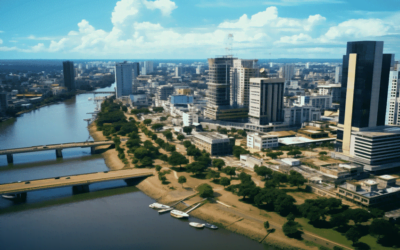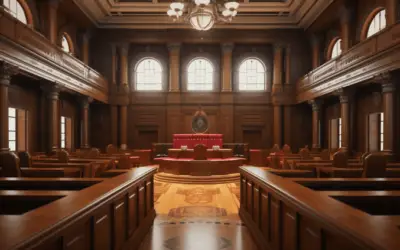Hey there, fellow drone enthusiasts! Ever found yourself passionately exploring the skies with your drone, only to be puzzled by the intricacies of Lithuania’s drone laws? Don’t worry; you’re not alone.
Many of us have shared that frustration, desperately searching for clear, concise answers to navigate the legal skies of Lithuania. Well, I’ve been there too, and let me tell you, the quest for understanding Lithuania’s drone laws led me on a fascinating journey.
After diving headfirst into the realm of regulations, I undertook an in-depth research mission. I scoured official documents, chatted with seasoned drone pilots, and even consulted with experts to unravel the complexities.
Armed with this wealth of knowledge, I can confidently say, “I’ve got you covered.” Whether you’re a traveler itching to capture Lithuania’s beauty from above or a local drone aficionado seeking to expand your flying horizons, I’ve got the answers you crave.
So, dear reader, if you’re yearning for a solution to your drone law queries, look no further. In the pages that follow, I’ll walk you through Lithuania’s drone laws with a friendly, conversational tone.
No more baffling legalese or confusing jargon. It’s all about empowering you to take to the Lithuanian skies responsibly and confidently. Ready to soar? Well then, let’s dive in and decode Lithuania’s drone laws together!
- Overview of Drone Laws in Lithuania
- Drone Categories in Lithuania
- Requirements for Visitors to Lithuania
- Lithuania Drone Laws: Regulations for Government Drone Operators
- Lithuania Drone Laws: No-Fly Zones and Restricted Areas
- Lithuania Drone Laws: Altitude Restrictions
- Lithuania Drone Laws: Visual Line of Sight (VLOS)
- Safety and Privacy Considerations
- Future Developments and Updates
- Final Thoughts on Lithuania Drone Laws
- Frequently Asked Questions About Lithuania Drone Laws
Overview of Drone Laws in Lithuania

When it comes to understanding drone laws in Lithuania, it’s essential to embark on a journey through history.
Lithuania, like many countries, recognized the need to regulate the skies as drones gained popularity. The introduction of drone regulations marked a significant shift, shaping how residents and visitors engage with this exciting technology.
So, let’s roll back the clock a bit. Lithuania’s drone regulations were introduced in response to the growing drone enthusiast community and the need for airspace safety.
Over time, the Lithuanian authorities realized that there was a necessity to ensure responsible drone operations in the country.
And just like that, they set the stage for a well-structured framework that not only safeguarded the skies but also made it accessible to all, residents and visitors alike.
Now, let’s talk about the regulatory authority in Lithuania. The guardian of Lithuania’s drone skies is the Lithuanian Transport Safety Administration (LTSA). This authority takes its role seriously, ensuring that drone operations in Lithuania are not just safe but also in compliance with the law.
It’s your go-to place for information, rules, and regulations about drone operations in the country. They play a pivotal role in ensuring that the skies remain open, accessible, and secure for drone pilots.
Why is all this essential, you may wonder? Well, regardless of whether you’re a resident or a visitor in Lithuania, adhering to drone laws is crucial. It’s not just about rules and regulations; it’s about maintaining a responsible and respectful approach to flying drones.
It’s a matter of safety, both for yourself and others. Whether you’re a local drone enthusiast or a traveler wanting to capture Lithuania’s breathtaking landscapes from above, understanding and following these laws is your passport to an enjoyable and trouble-free drone experience.
It’s about embracing the skies while respecting the rules that ensure that everyone can share in the magic of drone flight.
Also Read: Liechtenstein Drone Regulation 2024
Drone Categories in Lithuania

Drones, those fascinating flying machines, come in all shapes and sizes, each serving a unique purpose in Lithuania’s airspace. In this section, we’ll delve into the intricacies of how these drones are categorized and what that means for enthusiasts and professionals alike.
Drones are categorized based on weight and purpose
Drones, or Unmanned Aerial Systems (UAS), in Lithuania are classified primarily based on their weight and intended purpose.
The weight classification typically separates drones into several categories, ranging from tiny, featherweight drones to larger, more robust ones.
The purpose classification distinguishes between recreational and commercial drones, with different rules and requirements for each.
Rules and requirements for recreational and commercial drones
Here’s where it gets interesting. Lithuania has specific rules and requirements for both recreational and commercial drone operators.
Recreational drone pilots, those who fly drones for fun, have a set of guidelines to follow that differ from the more stringent regulations imposed on commercial operators. These rules encompass various aspects like registration, flight restrictions, and safety measures, all tailored to ensure that drone operations are not only enjoyable but also safe and responsible.
So, whether you’re a casual drone enthusiast or a professional aerial photographer, Lithuania’s drone laws have you covered, making sure the skies are open to all with a keen eye on safety and responsibility.
Also Read: Libya Drone Regulation 2024
Requirements for Visitors to Lithuania

Are you a drone enthusiast planning to visit the beautiful landscapes of Lithuania and eager to capture the magic from above? If so, it’s essential to understand the specific requirements and regulations you’ll need to adhere to as a foreign visitor.
In this section, we’ll explore what you need to know to make your drone experience in Lithuania both memorable and in compliance with the law.
foreign visitors interested in flying drones in Lithuania
For international travelers with a passion for drone photography or just the thrill of piloting, Lithuania offers a captivating playground.
Before taking a flight, it’s essential to familiarize yourself with the local regulations, which apply to both residents and visitors. Knowing where you can fly, what to do, and what to avoid ensures that your drone adventure is free from hassles and disappointments.
Foreign visitor drone pilot license requirements
To navigate Lithuania’s drone-friendly skies, foreign visitors are required to obtain a drone pilot license. This is a vital step that ensures you have the knowledge and skills to operate your drone safely and responsibly while capturing the beauty of Lithuania.
Acquiring this license may involve passing a knowledge test, so be sure to prepare for it before you arrive.
Mandatory drone registration for tourists.
When you touch down in Lithuania and are eager to explore the scenic landscapes, don’t forget to register your drone.
The registration process is essential for both residents and tourists. It helps authorities keep track of drones and their operators while ensuring accountability in the event of any incidents or issues during flight.
Remote ID regulations for tourists
While registering your drone, you won’t need to worry about Remote ID requirements. Unlike some countries, Lithuania does not currently mandate Remote ID for tourists. This simplifies the process and allows you to focus on your aerial adventures without additional technical requirements.
Drone insurance (recommended but not mandatory)
While drone insurance isn’t mandatory for tourists, it’s a smart move. Having insurance provides you with peace of mind, protecting you from potential liabilities or damages that may occur during your drone flights.
It’s a safeguard that ensures you can fully enjoy your journey without undue concern. So, whether you’re soaring over Lithuania’s pristine lakes or capturing its historic architecture, remember that having insurance is a choice you won’t regret.
Also Read: Liberia Drone Regulation 2024
Lithuania Drone Laws: Regulations for Government Drone Operators

Government drone operations play a crucial role in various aspects of Lithuania’s governance, from surveillance to emergency response.
This section offers insights into the regulatory framework that guides these operations, ensuring that government drones operate safely and responsibly in Lithuanian airspace.
Government drone operations in Lithuania
Government drone operations in Lithuania span a wide range of activities, including but not limited to law enforcement, search and rescue missions, and environmental monitoring.
These operations contribute to enhancing safety and security while aiding in disaster management and resource conservation.
Requirements for government drone pilot licenses
Just like civilian drone pilots, government drone operators are required to possess the necessary knowledge and skills to operate drones safely.
This typically involves obtaining a government drone pilot license, which ensures that operators are well-versed in regulations and safety practices specific to their missions.
Mandatory drone registration for government operations
The necessity of drone registration is not limited to recreational and commercial operators. Government drone operations also require the registration of their equipment. This process helps maintain transparency and accountability in government drone usage.
Remote ID regulations for government drone operators
Remote ID, while not required for tourists, is relevant for government drone operators. It enhances the safety and security of drone operations by allowing authorities to track and identify drones in real-time.
This capability is especially crucial for government activities involving airspace management and surveillance.
Insurance considerations for government drone operations
Insurance plays a significant role in the risk management of government drone operations. While it may not be mandatory, government agencies often invest in insurance coverage to protect against unforeseen incidents and potential liabilities.
Ensuring that their drone operations are financially secure helps them carry out their missions with confidence, no matter the challenges they may face.
Also Read: Lesotho Drone Regulation 2024
Lithuania Drone Laws: No-Fly Zones and Restricted Areas

Navigating the skies with a drone is exhilarating, but it comes with a responsibility to respect no-fly zones and restricted areas. Understanding the significance of these restrictions and how to stay informed is crucial for a safe and enjoyable drone experience in Lithuania.
Restricted areas, including airports, military zones, and sensitive locations
Restricted areas encompass various zones that are off-limits to drones. These areas typically include airports, military installations, and other sensitive locations.
The reason for these restrictions is straightforward: to safeguard public safety, national security, and privacy. Drones flying near airports, for example, can pose a significant risk to manned aircraft, which is why strict no-fly zones are in place.
Consequences of flying drones in no-fly zones
The consequences of flying drones in no-fly zones can be severe. Aside from the inherent safety risks, violating no-fly zone regulations can result in legal consequences, including fines or even criminal charges.
Moreover, it can lead to damage to or disruption of critical infrastructure and create public unease. Understanding and respecting these restrictions is not just a legal requirement; it’s a moral obligation to ensure safety and security.
Information on restricted areas
Staying informed about no-fly zones and restricted areas is vital for responsible drone operation. The Lithuanian Transport Safety Administration (LTSA) and other relevant authorities regularly update information on these areas.
As a responsible drone operator, it’s essential to regularly check for updates on restricted zones. Many authorities provide online tools or apps that help drone pilots identify no-fly zones and ensure their flights comply with regulations.
Always verify the latest information before each flight to ensure a safe and law-abiding experience.
Also Read: Lebanon Drone Regulation 2024
Lithuania Drone Laws: Altitude Restrictions

When we take to the skies with our drones, understanding altitude restrictions is not just about complying with the law; it’s about ensuring the safety of all those who share the airspace with us.
Let’s explore the importance of adhering to altitude regulations for a secure and lawful drone experience in Lithuania.
Altitude limits for drone operations in Lithuania
Lithuania, like many countries, imposes specific altitude limits for drone operations. Generally, the maximum allowed altitude for drones in Lithuania hovers below 120 meters (around 400 feet) above ground level.
These restrictions are in place to prevent conflicts with manned aircraft, which typically operate at higher altitudes.
Adhere to altitude restrictions for safety and legal compliance
Adhering to altitude restrictions isn’t merely about following the law; it’s about being a responsible drone pilot. Flying too high can lead to potential hazards, such as collisions with aircraft or interference with other drones.
It’s a matter of safety, not only for your own drone but also for the well-being of those on the ground and in the air.
Furthermore, respecting altitude limits ensures that you stay on the right side of the law. Violating these restrictions can lead to legal consequences, including fines and penalties.
By flying within the prescribed altitude limits, you not only enhance safety but also contribute to a positive image of the drone community, fostering a sense of responsibility and respect for regulations among all operators.
So, whether you’re capturing captivating aerial views or surveying landscapes, remember that keeping your drone within the altitude restrictions is both a legal requirement and a moral imperative.
Also Read: Latvia Drone Regulation 2024
Lithuania Drone Laws: Visual Line of Sight (VLOS)

Maintaining a clear line of sight with your drone is a fundamental aspect of responsible drone operation. In Lithuania, as in many other places, the Visual Line of Sight (VLOS) requirement ensures that pilots maintain a direct and unobstructed view of their drones.
Let’s explore what this requirement means and when, under certain circumstances, it may be exceeded with proper authorization.
VLOS requirement
The VLOS requirement is a core safety guideline for drone pilots. It means that you must keep your drone within your line of sight during the entire flight.
This enables you to maintain direct control over the drone, assess its surroundings, and respond to any unexpected situations.
Operating your drone outside of your line of sight may pose safety risks, as you may not be aware of obstacles or other aircraft that could jeopardize your flight.
VLOS may be exceeded with proper authorization
While the VLOS requirement is essential for safe and responsible drone operations, there are circumstances when it may be exceeded with the proper authorization.
In Lithuania, you can request special permission from the relevant authorities to fly your drone beyond the VLOS. This is usually granted for specific purposes, such as research, surveying, or other missions that require extended flight ranges.
It’s important to note that obtaining such authorization involves demonstrating that you have the necessary equipment and procedures in place to ensure safety during extended-range operations.
So, while VLOS is a general rule, it’s reassuring to know that you have the option to seek exceptions for specific missions when required.
Also Read: Laos Drone Regulation 2024
Safety and Privacy Considerations

Ensuring safety and respecting privacy are essential aspects of responsible drone operations. In Lithuania, these considerations are not just legal obligations; they’re also ethical imperatives.
Let’s delve into the guidelines for ensuring safety during drone operations and the significance of respecting privacy laws while capturing the beauty of Lithuania from the sky.
Guidelines for ensuring safety during drone operations
Safety is paramount when you’re the pilot of a flying machine. The safety guidelines for drone operations in Lithuania cover a range of aspects, including pre-flight checks, responsible flying practices, and understanding your drone’s capabilities.
This means conducting thorough pre-flight inspections, maintaining safe distances from people and property, and being vigilant about your surroundings. Practicing these guidelines isn’t just about following the law; it’s about safeguarding lives, property, and the reputation of the drone community.
Respecting privacy laws when flying drones in Lithuania
Respecting privacy laws is equally crucial. Drones equipped with cameras can capture stunning aerial views, but they can also intrude on people’s privacy if not used responsibly.
In Lithuania, like in many countries, flying your drone in a manner that invades someone’s privacy or captures sensitive information without consent is illegal.
Respecting individuals’ rights to privacy while still enjoying the benefits of drone technology is essential for maintaining a positive and responsible image among drone enthusiasts.
By doing so, you contribute to the coexistence of drones and privacy rights, ensuring that everyone can enjoy the magic of aerial photography while feeling secure in their privacy.
Also Read: Kyrgyzstan Drone Regulation 2024
Future Developments and Updates

The world of drone regulations is ever-evolving, adapting to technological advancements and changing safety considerations. Lithuania is no exception to this, and staying informed about the potential for changes and updates to its drone laws is a responsibility we all share.
Let’s explore the importance of keeping an eye on evolving regulations and being prepared for what lies ahead.
potential for changes and updates to Lithuania’s drone laws
Lithuania’s drone laws, like those in many countries, may undergo changes and updates over time. These modifications can encompass a variety of aspects, such as altitude limits, flight restrictions, or registration requirements.
It’s essential to be aware that the regulatory landscape may shift to address emerging challenges or technological advancements.
Whether it’s adapting to new drone models, enhancing safety measures, or responding to public concerns, staying open to potential changes is part of being a responsible drone operator.
The significance of staying informed about evolving regulations
Why should you care about the potential changes in drone regulations? Simply put, staying informed is the key to a responsible and lawful drone operation.
Being aware of new developments ensures that you continue to operate your drone safely and legally. Ignoring updates may lead to unintentional violations or missed opportunities for more enjoyable and innovative drone experiences.
Whether you’re a local enthusiast or a visiting pilot, being vigilant about evolving regulations is a vital part of being a responsible member of the drone community.
So, as you embark on your drone adventures in Lithuania, remember that being well-informed is your passport to future skies.
Also Read: Kuwait Drone Regulation 2024
Final Thoughts on Lithuania Drone Laws

As we wrap up our journey through Lithuania’s drone laws, it’s time to reflect on the key takeaways and the importance of responsible drone operation in this beautiful country.
Lithuania’s drone laws are not just a set of rules and regulations; they are a foundation for safe, enjoyable, and respectful drone experiences.
These laws ensure that both residents and visitors can explore the skies while maintaining the highest standards of safety and responsibility.
It’s an acknowledgment that the Lithuanian skies are a shared resource, and by following these laws, we contribute to a vibrant and respectful drone community.
To all the fellow drone enthusiasts out there, I want to extend an encouraging message. Adhering to Lithuania’s drone laws isn’t a burden; it’s an opportunity.
It’s a chance to capture breathtaking landscapes, tell unique stories, and share unforgettable moments with a global audience.
By following these regulations, we not only ensure our personal safety but also contribute to a culture of responsibility and respect that benefits everyone.
So, whether you’re a local enthusiast or a traveler eager to explore Lithuania’s beauty from above, remember that safe and responsible drone operation isn’t just a choice; it’s a commitment to preserving the magic of flight and the spirit of exploration. Happy flying!
Frequently Asked Questions About Lithuania Drone Laws
As drone enthusiasts and responsible operators, it’s natural to have questions about the laws and regulations that govern drone flights in Lithuania. Let’s explore some of the most commonly asked questions to provide you with clear and concise answers that align with Lithuania’s drone laws and regulations.
1. Do I need a drone pilot license to fly in Lithuania as a foreign visitor?
Yes, as a foreign visitor, you are required to obtain a drone pilot license to operate a drone in Lithuania. This license ensures that you have the necessary knowledge and skills to operate your drone safely and responsibly. It may involve passing a knowledge test, so be sure to prepare for it before your visit.
2. Is drone registration mandatory for tourists in Lithuania?
Yes, drone registration is mandatory for both residents and tourists in Lithuania. This process helps authorities keep track of drones and their operators, ensuring accountability in case of incidents or issues during flight. Registering your drone is a fundamental step to ensure you’re operating within the law.
3. Are there altitude restrictions for drone operations in Lithuania?
Yes, Lithuania imposes altitude restrictions for drone operations. The maximum allowed altitude typically falls below 120 meters (approximately 400 feet) above ground level. Adhering to these restrictions is vital for safety and legal compliance. It helps prevent conflicts with manned aircraft and enhances overall safety.
4. Can I fly my drone beyond the Visual Line of Sight (VLOS) in Lithuania?
While Lithuania follows the general rule of maintaining Visual Line of Sight (VLOS) during drone flights, there are circumstances when VLOS may be exceeded with proper authorization. Special permissions can be sought for specific missions, such as research or surveying, which require extended flight ranges.
5. What are the consequences of flying drones in no-fly zones in Lithuania?
Flying drones in no-fly zones in Lithuania can have severe consequences. Aside from the safety risks, violations can result in legal consequences, including fines or even criminal charges. Moreover, it can lead to damage or disruption of critical infrastructure and create public unease. It’s essential to respect these restrictions for safety, legality, and social responsibility.













